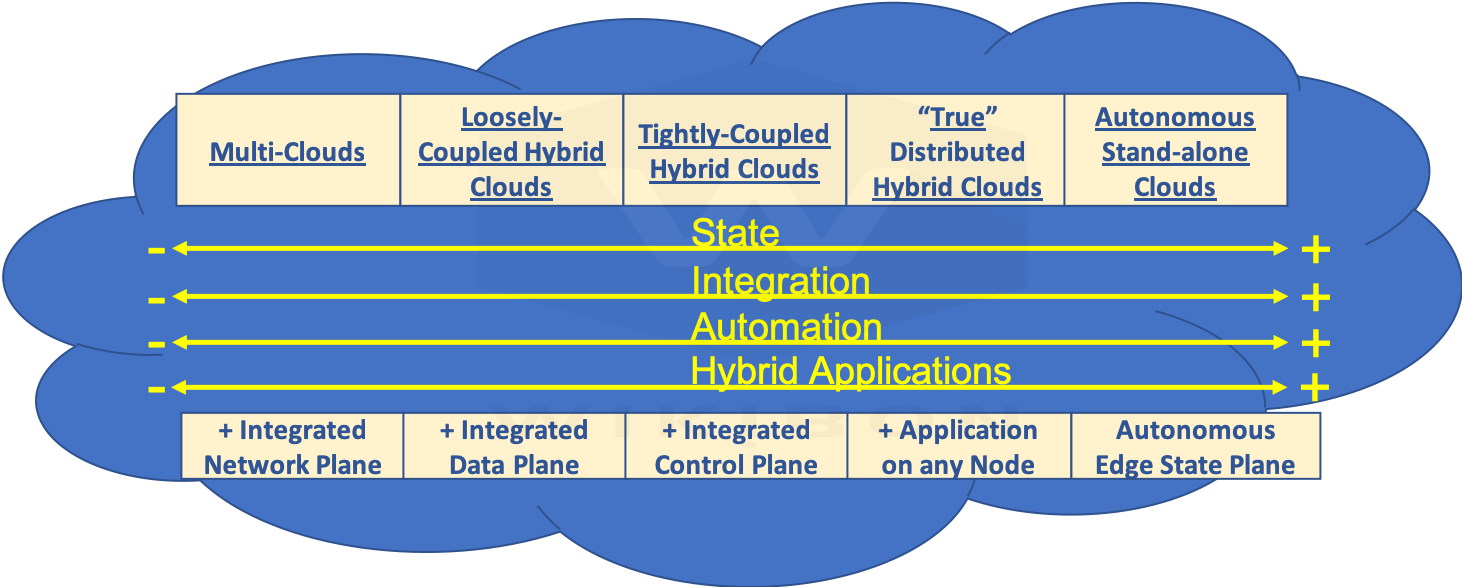Premise
Google has recently introduced Google Hybrid Cloud offerings, with Google Cloud Anthos on-site software that is integrated with Google cloud. This is new territory for Google. The premise of this research is to lay out what Google should address to be successful. These success factors include:
- Google Adopts a Cloud-first Hybrid Architecture
- Google Supports High-value Enterprise Applications
- Google Defines On-premises Hybrid Cloud Value Propositions
- Google Defines Hybrid Cloud Value Propositions at the Edge
- Google Supports HCI & “Single Throat to Choke”
- Google Develops Sustainable Long-term Partnerships
- Google Supports Multiple Networking, Data, Control, Security & Compliance Planes
- Google Hybrid Cloud Runs across most Cloud Platforms
- Google is Trusted to Respect Customer Ownership of Data
We will use this as a checklist to define the steps that Google should take, assess future hybrid cloud enhancements Google does take, and evaluate the overall value and chances for success of Google Hybrid Cloud.
Google Hybrid Cloud so far…
Google Cloud announced Anthos in April 2019. This was previously known as Cloud Services Platform (CSP), announced in July 2018. Anthos is a version of Google’s Kubernetes Engine built to deploy in an enterprise on-premises datacenter. Anthos allows enterprises to deploy build on-premises instances of Google’s cloud service.
Google Cloud delivered a beta version of Anthos that enables enterprises to deploy GKE On-Prem. This runs an integrated stack including OS, container runtime, Kubernetes, and the cloud to which it connects. on partner equipment inside the enterprise datacenter. This allows movement of workloads between on-premises and Google Cloud, access to data from all nodes of the hybrid cloud, and centralized control software to manage the processes.
GKE On-Prem now support for stateful environments. It allows attachment of persistent storage to containers, and supports some databases. Google Cloud Build supports deployment of containers to any Kubernetes Engine cluster, cloud, or Anthos on-prem. Google Cloud Console is a control plane which allows administrators to monitor, manage, and enforce policies across Kubernetes Engine clusters, both in the cloud an on-prem.
A key reason for this activity is that the enterprise IT world has embraced a hybrid model for cloud, and in practice have already deployed multiple IaaS clouds, SaaS clouds and private clouds. Many cloud vendors have announced hybrid cloud strategies, including AWS Outposts, Cisco HyperFlex and Cisco Application Centric Infrastructure offerings integrated with Google Anthos, IBM Z Cloud, IBM Private Cloud, HPE, Microsoft Azure Stack, Iguazio, Oracle Cloud at Customer, Nutanix, VMware with AWS Outpost and Dell VxRail, and many others.
Hybrid Cloud Taxonomy
Figure 1 below shows the Wikibon Hybrid Cloud Taxonomy, which is described in detail in previous research entitled “Hybrid Cloud Taxonomy”. In general, the value of hybrid cloud to enterprises increases from left to right.
Google Anthos is defined in Figure 1 as a Tightly-coupled Hybrid cloud. Google is competing with many other cloud providers. In particular, it is competing with other high-value Tightly-coupled Hybrid Cloud offerings such as AWS Outposts, Microsoft Azure Stack, and others.

Source: © Wikibon 2019.
Google Hybrid Cloud Success Factors
The nine success factors outlined in the premise are analysed in the nine sections below.
1. Google Adopts a Cloud-first Hybrid Architecture
The AWS & Microsoft hybrid clouds both implement Cloud-first architectures. New function is developed in the cloud, and passed down on a regular cadence to the on-premise version. For example, Amazon Stack updates are monthly, and customers cannot be more than 2-3 months behind before they fall out of support.
This continuous development model enables faster development of cloud and hybrid cloud functions. Google should adopt a cloud-first architecture.
2. Google Supports High-value Enterprise Applications
Figure 1 shows greater levels of integration from left to right. In general, the greater the integration, the more data that can be processed, and the greater the application value generated for an enterprise.
The major reasons for running applications on-premises or at the Edge are to improve access latency, to eliminate the cost and delay of moving data to the public cloud, and/or to reduce risk and improve data compliance. The principle is to move code and services to the data, and enable data driven distributed hybrid applications.
One example of a high-value applications is AI inference code running directly at the point of data creation. Another example is a complex set of advanced analytics running against data in the public cloud and on-premise which will allow a data driven (real-time) updating of prices in the existing mission systems of record. Another example is to provide a fraud assessment in real-time before the system of record transaction is completed.
These types of application have the potential for integrating and automating existing business processes, and the ROI from automation is orders of magnitude greater than just making people smarter.
3. Google Defines On-premises Google Hybrid Cloud Value Propositions
Google will need to bring ideas and templates for applications across many industries, and ensure tight integration between the stateless world of containers, Kubernetes & Istio, and the stateful world of systems of record.
One very important advantage of enabling the types of data driven hybrid applications discussed in the previous section is avoiding the conversion of existing systems of record. Conversion projects are high-risk multi-year projects which freeze new functionality, and CIOs avoid them like the plague.
It is better to integrate and enhance existing systems of record. An example of this is Cisco Hybrid Cloud Platform for Google Cloud, which can expose a legacy application to the cloud via APIs. This allows legacy applications to be incorporated into a cloud workflow.
Google should adopt an inclusive hybrid cloud strategy of enhancement, rather than advocate for a single monolithic cloud.
4. Google Defines Google Hybrid Cloud Value Propositions at the Edge
IoT, IIoT and robotics, combined with inference AI, are moving code to the edge near the sensors, and inside smart sensors. This is creating the Autonomous Distributed Edge, which will hold state in locally distributed memory, extract value from data by tight immersion and integration with the sensors, extract specific additional value with special code from AI central development, and finally discard the data husks empty of all value.
The Edge is a multi-architectural environment. Arm, Intel & other processors, GPUs and neural networks will be assembled together into volume solutions by specialist companies. Arm is already dominant in the sensor and smart sensor space, because of cost and power advantages.
Google will need to embrace Google cloud working on Arm and other processors, and take advantage of the high volume lower cost equipment available at the Edge.
5. Google Hybrid Cloud Supports HCI & “Single Throat to Choke”
CIOs are very anxious to avoid the return of multiple teams to manage on-premises equipment as part of hybrid cloud. Hyper-converged equipment is software defined, and can be very tightly integrated with the cloud stack. This is true for on-premises or Edge implementations.
AWS install and maintain their own HCI equipment to solve this problem, as does Oracle Cloud at Customer. Dell/Microsoft is another example of joint development of highly integrated hardware and software, which have engineered to work together and be updated together. All the traditional customer work of patching is outsourced to Dell/Microsoft.
It could be tempting for Google Cloud executives to differentiate and say they offer a software-based solution running on any old hardware. Google also needs highly integrated HCI offerings with strong infrastructure partners such as Cisco, Dell and HPE. The partners will need to offer a seamless hybrid cloud solution, with zero maintenance and a single throat to choke.
6. Google Hybrid Cloud Develops Sustainable Long-term Partnerships
The above sections illustrate Google must develop and maintain sustainable long-term partnerships. These include partners for infrastructure, software, SaaS, industry solutions, and other cloud providers. These partnerships can help develop and implement secure high-value hybrid applications fully integrated with all data sources.
This partnership development is a difficult and long-term commitment for Google. It will need some serious investment in people to develop these partnerships. The traditional Google marketing approach of “read my blog” is unlikely to be sufficient.
7. Google Hybrid Cloud Supports Multiple Networking, Data, Control, Security & Compliance Planes
Figure 1 above shows that Hybrid Clouds need to manage state, need tightly integrated data planes, and need integrated control planes enabling orchestration and operational automation. In addition, security and compliance planes are essential.
These are table stakes to enable hybrid application development and deployment. There is room for multiple planes of all types to support the rich range of data, applications and business processes that will develop over the next decade.
8. Google Hybrid Cloud Supported across All Cloud Platforms
It goes without saying that Google Cloud platform should be running natively on a majority of international cloud platforms. This would introduce a true hybrid-cloud paradigm for enterprises. The focus of IT resources on hybrid application functionality will help to break down barriers between clouds, and enable specialist cloud services to flourish.
9. Google Continues to be Trusted to Respect Customer Ownership of Data
Google has built the world’s largest clouds, supporting a set of consumer and business services. Behind these is a highly efficient and effective business clouds that sells internet and mobile advertising, and is responsible for over 90% of its revenue. It shares this market with Facebook and many much smaller competitors.
Google consistently communicates what it stands for as a company, and has built a good reservoir of trust for its services. It has avoided the pitfalls that Facebook faces. During Google’s investment in Waymo to develop AI for autonomous car systems, it has avoided the mistakes of Uber, Tesla and recently Boeing, and cooperated well with government agencies.
Google has been fined $10 Billion in Europe because it did not understand the European cultural and legal differences compared with the US. Google will need to work on trust in outside of the US, which will be vital to increase worldwide volume demand for its cloud products.
Overall, Google is in a good position to earn the trust of businesses and developers in developing Google Cloud and hybrid cloud services.
Conclusions
The development of containers, Kubernetes & Istio is arguably the fastest technology adoption so far in IT history. It has a chance of becoming the de facto standard for much hybrid cloud computing.
The greatest initial return on investment from Google’s hybrid cloud will be on-premises deployments enabling data driven applications that are fast enough and data-rich enough to help automate existing systems of record and the business processes they support.
If Google cloud hybrid cloud initiatives falters and loses momentum, the prospects for an open multi-cloud environment fall dramatically. AWS, Microsoft, and others are very likely to take the open-source code, add their control and data planes, fork the code, and neutralize the threat of Kubernetes, Istio and other hybrid services to their businesses.
Google has a unique opportunity to establish containers, Kubernetes, and Istio together with varied networking, control, security and compliance functionality as the software building blocks of hybrid cloud. It will save the world $Trillions if it succeeds.
Action Item
Large enterprises, the majority of IT companies, and worldwide government agencies should support Google’s Cloud and Google Hybrid Cloud services. They should work to preserve the openness of the platform, and an open multi-cloud environment. Cisco, Dell, HPE, IBM/Red Hat, Oracle, network providers, and smaller cloud providers have much to gain by helping the development and adoption of these inter-cloud standards.


